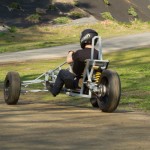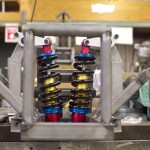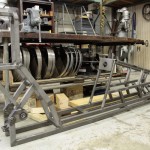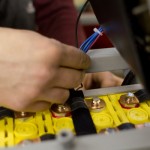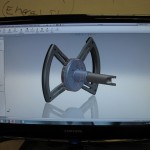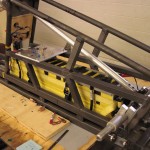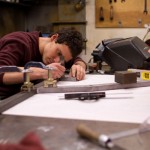The mission of the Hampshire College Lemelson Center in Amherst, Mass. is to help drive students to art, design and innovation for social change via working in the areas of applied design, appropriate technology, social entrepreneurship and art & technology. A few of its Division III students certainly seem to be following that motto, finishing a bit ago a unique electric vehicle project built from the ground up by them that aims to make a difference in the way we move around the world on a daily basis in our cars and trucks.
The finished product is known as the EV-XI. Built by Aaron Cantrell, Jake Horsey and Prateek Rajbhandari, it looks like something one might see from a road warrior of the future apocalypse type movie, only in this case it would allow one to silently sneak up on the bad guys manning the road block in the middle of the deserted highway. It was fundraised, designed and completely fabricated in a quick and rather impressive eight months.

Via a vividly detailed photographic display up on Coroflot by Horsey we see the stages of this project’s development from conceptualization through the final electric vehicle. The EV-XI, in terms of specifications and performance, is powered by a 10 kW DC PM motor and a 2.5 kWh, 48 volt lithium ion battery. It can, at 300 amps max output, accelerate to a nice top speed of 40 MPH in around 4.5 seconds.
Sporting a frame of 4140 high carbon steel and a drive train that is a belt drive to jackshaft with QD pulleys, to a chain final drive, the open three wheel, one seater has a very light weight of just 380 pounds with the batteries.
All images via Jake Horsey/Coroflot
Cantrell notes on his portfolio site that this vehicle was completely designed in SolidWorks and every part modeled before fabrication began. Almost all parts of car were “machined and welded by the three of us, including the chassis, the rack and pinion, the steering wheel, pedal assembly and even the gearing.”
The inspiration for the EV-XI comes from the designers’ love of bicycles and a
desire to positively impact the world around us. Transportation is a significant part of our lives. We ride to commute, to compete, and to enjoy. We recognize that the intense resource demands of current transportation technologies are a significant issue and must be addressed in order to facilitate the establishment of sustainable systems within our society.
“The goal of this project is to engage with the process of vehicle design and learn what it means to develop a transportation technology,” said the students. “We’ve spent our time in school learning to observe our environment, analyze information, and produce solutions based on our conclusions. We’re approaching this project by first framing a question to guide our observations: can we design and manufacture an ‘alternative’ vehicle that satisfies commuter requirements, efficiently utilizes non-petrol based energy, and delivers an exciting and engaging user experience?”
Testing from Jake Horsey on Vimeo.
211 photos and two videos later on their Flickr stream, they look to just have accomplished that and perhaps more. Since the time of the vehicle’s development, it has been shown at “an entrepreneurship conference as well as a renewable energy workshop with very positive reception that ignites conversation about the future of transportation.”
